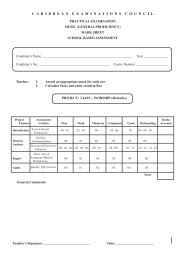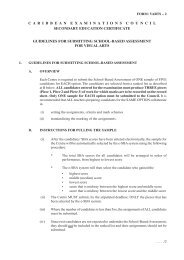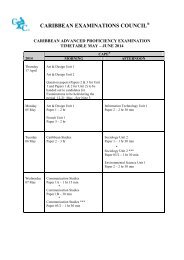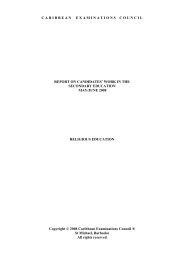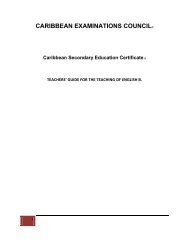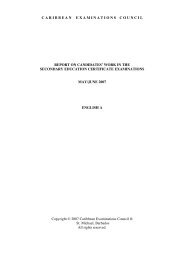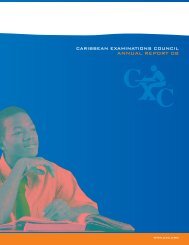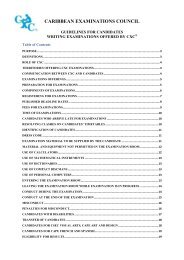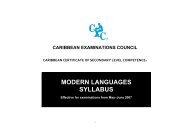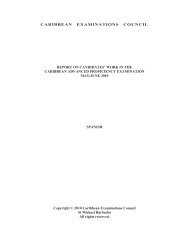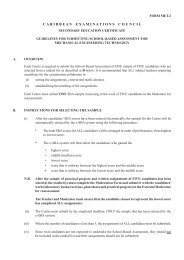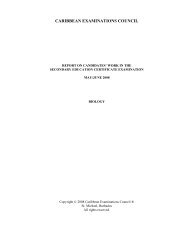CXC Examiner May 2012 - Caribbean Examinations Council
CXC Examiner May 2012 - Caribbean Examinations Council
CXC Examiner May 2012 - Caribbean Examinations Council
Create successful ePaper yourself
Turn your PDF publications into a flip-book with our unique Google optimized e-Paper software.
The <strong>Caribbean</strong> <strong>Examiner</strong>RECOGNITION OF <strong>CXC</strong> QUALIFICATIONSUS HigherEducationWelcomes<strong>Caribbean</strong>StudentsBy Tim WrightThe United States has one of the mostdiverse, decentralised, and prolific educationsystems in the world. With more than 4,500accredited institutions of higher education,there are a plethora of choices, differences, andnuances that contribute to the reputation ofacademic excellence for which US colleges anduniversities are known. For nearly a century, UScolleges and universities have been a safe havenfor international students and scholars and inthe past decade alone, the higher educationcommunity’s interest in attracting internationalstudents has grown enormously.According to the 2011 Open Doors report,published by the Institute of InternationalEducation, there were 723,227 internationalstudents studying in the US during the 2010/11academic year, a 4.7 per cent increase from theprevious year. If you look back to just afterSeptember 2011 when there were 582,996international students in the U.S., this growth isa significant indicator that the US’s is committedto keeping its doors open to internationalstudents. For the past ten years, the number ofstudents from the <strong>Caribbean</strong> studying in the UShas averaged at approximately 15,000. WhileChina, India and South Korea dominate theinternational student market in the US with 42per cent of the international total, the <strong>Caribbean</strong>holds rank as the region that sends more ofits college-aged population to study in the USthan any other region in the world-all of Asiacombined. Admissions offices from US collegesand universities are taking note. With numbersof <strong>Caribbean</strong> students in the US declining inrecent years (12,821 in 2010/11), dozens ofinstitutions are ramping up their recruitingefforts and traveling to the region, either to visitTABLE 1TOP RECEIVING STATES OFCARIBBEAN STUDENTSFLORIDA 18.8%NEW YORK 15.8%TEXAS 5.3%GEORGIA 4.2%LOUISIANA 4.0%TABLE 2US COLLEAGES ANDUNIVERSITIES ENROLLING 100OR MORE CARIBBEAN STUDENTSBarry UniversityBroward CollegeCUNY Bronx Community CollegeFlorida International UniversityGrambling State UniversityMiami-Dade CollegeNassau Community CollegeNova Southeastern UniversitySUNY Westchester Community CollegeUniversity of FloridaUniversity of South FloridaUniversity of TampaUtah State UniversityWestern Michigan UniversitySOURCE: OPEN DOORS REPORT: 2011individual islands or as part of the annual collegefairs organised by local ministries, secondaryschools or US Embassies.While there is strong student mobilitybetween the region and the US, <strong>Caribbean</strong>students lack adventure in their geographicand institutional preferences. As a graduate ofRoanoke College, a small liberal arts college in arural area of southwest Virginia, I know firsthandthe value of looking beyond the Ivy League,going to institutions off of your own ‘beatenpath’ and out of your comfort zone. Statisticallyspeaking for the <strong>Caribbean</strong>, all roads on thatbeaten path lead to Florida and New York (35%of the total) (see Table 1). These are two stateswith outstanding educational institutions, myriadopportunities for many students to live withrelatives or within existing support networks,and a handful of public institutions, especially inFlorida, that offer financial incentives specificallyfor <strong>Caribbean</strong> students.While that is just fine and dandy, a studentwilling to be more adventurous, to wanderfurther from this standard student mobilitypathway and look for alternative options willlikely be rewarded with a more robust culturalexperience as well as a more lucrative financialaid package. This should be a key strategy for astudent interested in studying in the US but inneed of significant financial assistance: go whereno <strong>Caribbean</strong> student has gone before.Increasingly, more colleges and universitiesoutside of Florida and New York are recruitingmore actively in the <strong>Caribbean</strong> and looking toincrease the number of students from this regionon their campuses (See Table 2). The <strong>Caribbean</strong><strong>Examinations</strong> <strong>Council</strong> is helping this effort bydoing considerable outreach within the US higher34 MAY <strong>2012</strong> www.cxc.org



